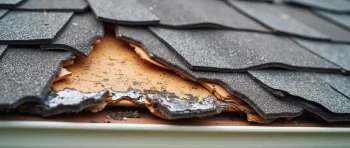When was the last time you thought about your roof? If you're like most homeowners, probably not since the last time something went wrong. I get it – your roof isn't exactly the most exciting part of your home. But it's silently working overtime to protect everything you love from the elements, day in and day out.
Here's the thing: your roof is trying to talk to you. Those little problems you've been ignoring? They're warning signs, and they won't fix themselves. In fact, that small issue you barely notice today could turn into a budget-crushing disaster tomorrow.
I've seen it happen too many times – homeowners calling in a panic after a minor leak suddenly became a ceiling collapse. That's why I put together this guide to help you catch problems early when they're still small, manageable, and much more affordable to fix.
1. Your Shingles Are Crying for Help
Take a look at your roof from the ground. Can you spot any:
- Missing shingles (those bare patches shouldn't be there)
- Curling edges (shingles should lie flat, not bend upward)
- Cracked surfaces (even small fractures spell trouble)
- Wavy or distorted sections (your roof should have clean, straight lines)
- Blistering (those little bubbles on the surface are a bad sign)
Your shingles age just like everything else, but damage often accelerates because of harsh weather, particularly those nasty wind storms or hail we get. Sometimes it's just age catching up, but occasionally poor installation or manufacturing issues are to blame.
Why should you care? Even one damaged shingle is like leaving your front door partially open during a rainstorm. It creates a vulnerable entry point for water that can silently wreak havoc on everything underneath.
2. Your Gutters Are Filling With Granules
Have you noticed what looks like dark sand in your gutters or collecting at the bottom of your downspouts? Those are granules from your shingles, and they're not supposed to end up there.
It's normal for a new roof to shed some excess granules initially (think of it like a new haircut shedding a few loose strands). But if your roof isn't new, finding a lot of these granules means your shingles are losing their protective armor.
Those little granules are crucial – they shield your shingles from harsh UV rays and help with fire resistance. Once they're gone, your shingles age much faster, like skin without sunscreen.
3. Those Water Stains Don't Lie
Few things sink a homeowner's heart faster than looking up and seeing a brownish stain spreading across the ceiling. It's like your house is telling you, "We have a problem."
If you're seeing:
- Yellowish or brown spots on your ceiling
- Water marks running down interior walls
- Stains that mysteriously appear or get darker after it rains
- Paint that's bubbling or wallpaper peeling near your ceiling
...then water is already getting inside your home. By the time you see these stains, the water has already made quite a journey – through your shingles, roof deck, and possibly insulation.
The usual suspects? Failed flashing around chimneys or vents, ice dams in winter, or compromised shingles. Whatever the cause, this isn't something that will fix itself.
4. Your Energy Bills Are Climbing For No Reason
Has your heating or cooling bill been creeping up without explanation? Your roof might be the hidden culprit.
Your roof and attic work together as part of your home's climate control system. When your roof is compromised, it often leads to insulation problems:
- Wet insulation doesn't insulate well (it's like trying to stay warm with a wet blanket)
- Gaps in your roof let your expensive heated or cooled air escape
- Poor ventilation creates extreme temperatures in your attic, making your HVAC work overtime
Beyond the hit to your wallet every month, these efficiency problems often point to moisture issues that could be causing hidden damage throughout your home.
5. Your Roof Is Starting to Sag
If your roof looks like it's smiling (with a dip in the middle) or has waves where it should be straight, that's a serious red flag requiring immediate attention.
Look for:
- Areas of the roof that appear to droop or sink
- A roofline that's no longer straight
- Ceilings inside that show unusual curves or dips
- Doors or windows suddenly sticking (this can indicate your home's structure is shifting)
A sagging roof isn't just an aesthetic issue – it's a structural one. It usually means water has been damaging your roof deck over time, supports have weakened, or there's too much weight on your roof. In worst cases, it could even point to foundation issues.
This isn't a "wait and see" situation. A sagging roof needs professional eyes on it right away before it progresses to a much more dangerous scenario.
6. You Can See Daylight Through Your Roof Boards
Head up to your attic on a sunny day, turn off the lights, and look up. If you see streams of light coming through, your roof has gaps that shouldn't be there.
Check for:
- Beams of light shining through the roof decking
- Visible openings around your chimney or vent pipes
- Light seeping in where the roof meets walls
- Small holes anywhere in the roof structure
It's simple physics – if light can get in, so can water, cold air, and even unwelcome critters. These gaps are direct pathways for moisture to enter during the next rainfall and can dramatically impact your energy efficiency.
7. Your Roof Has Started Growing
A roof should be made of roofing materials – not living organisms. If you're seeing green fuzzy moss or black streaks growing on your roof, it's cause for concern.
Look for:
- Moss patches between or on top of shingles
- Black streaking or discoloration (often algae)
- Any plant life that's made your roof its home, especially in shaded areas
- Growth that seems to accelerate after rainy periods
This usually happens in consistently damp environments or heavily shaded roof sections that don't dry out quickly. While it might seem mostly cosmetic, moss acts like a sponge, holding moisture against your roofing materials and accelerating deterioration. As it grows, it can even lift shingles and create gaps for water entry.
8. Your Flashing Is Failing
Flashing is like the strategic defense system of your roof, protecting vulnerable joints and transitions. When it fails, your roof's most sensitive areas are exposed.
Watch for:
- Rusty or corroded metal pieces around chimneys, vents, or skylights
- Flashing sections that appear loose or missing
- Cracked or damaged sealed joints
- Exposed nail heads
- Separation between flashing and roof surfaces
Flashing problems often develop from natural weathering, poor installation, or the constant expanding and contracting with temperature changes. Even small flashing issues can lead to significant leaks because they protect your roof's most vulnerable junctions.
9. Your Gutters Are Collecting More Than Just Leaves
While cleaning gutters is nobody's favorite chore, pay attention to what you're pulling out of them. If you're finding roofing materials mixed in with the usual leaves and twigs, your roof is shedding parts of itself.
Look for:
- Granules and small pieces of roofing material
- Fragments of shingles
- Pieces of flashing or roofing cement
- Gutters that clog and overflow easily
- Gutters pulling away from the fascia
Beyond indicating that your roofing materials are breaking down, clogged gutters create a cascade of other problems – they can force water back under your shingles, create dangerous ice dams in winter, and add stress to your roof's edge.
10. Your Roof Is Simply Getting Old
Sometimes the most telling sign is the simplest – your roof has served its time. Every roofing material has an expected lifespan:
| Roofing Material | Expected Lifespan | When to Start Worrying |
|---|---|---|
| Asphalt Shingles | 15-30 years | Curling edges, brittleness, bald spots |
| Wood Shingles/Shakes | 20-40 years | Splitting, warping, mold growth |
| Metal Roofing | 40-70 years | Rust spots, loose seams, denting |
| Tile Roofing | 50+ years | Cracked tiles, deteriorated underlayment |
| Slate Roofing | 50-100+ years | Cracked slates, worn flashings |
Even if your roof looks okay on the surface, an aging roof deserves professional inspection as it approaches these milestones. Think of it like taking your car in for service at certain mileage points – preventative care extends life and prevents sudden failures.
When It's Time to Call in the Pros
While some homeowners are comfortable handling minor repairs, roof work can be dangerous and technically complex. Consider calling a professional roofer when:
- You have active leaks or water stains
- Your roof is visibly sagging or deformed
- Multiple shingles are damaged or missing
- You're not comfortable working safely at height
- You've experienced severe weather recently
- You're seeing multiple warning signs at once
Finding the Right Roofing Professional
Not all roofers are created equal. When you're selecting someone to trust with this crucial home system:
- Verify they're licensed, bonded, and properly insured (ask to see proof!)
- Check references and read reviews from previous customers
- Get multiple quotes to compare (3-4 is ideal for major work)
- Make sure you understand the warranties offered
- For partial repairs, confirm the new materials will work with your existing roof
- Ask about manufacturer certifications, which may be required to maintain material warranties
The Real Cost of Procrastination
I've seen too many homeowners try to save money by postponing roof repairs, only to spend far more later. Here's how costs typically escalate:
| Initial Problem | Early Repair Cost | If Ignored... | Potential Cost After Delay |
|---|---|---|---|
| Few missing shingles | $150-$400 | Water damage to decking | $1,000-$3,000+ |
| Small leak | $300-$600 | Structural rot, mold | $2,000-$10,000+ |
| Damaged flashing | $200-$500 | Major interior water damage | $2,500-$15,000+ |
| Clogged gutters | $150-$300 | Ice dams, fascia damage | $800-$2,500 |
| Small repair area | $400-$800 | Complete roof replacement | $5,000-$25,000+ |
The numbers tell the story – addressing problems early isn't just convenient, it's financially smart.
Keeping Your Roof in Fighting Shape
An ounce of prevention is worth a pound of cure, especially when it comes to your roof. Here's a seasonal checklist to keep your roof performing at its best:
Spring Check-Up:
- Look for winter damage after the snow melts
- Clean those gutters of winter debris
- Scan for loose or damaged shingles
- After spring rains, peek in the attic for leaks
Summer Maintenance:
- Check for storm damage after severe weather
- Make sure your attic has proper ventilation
- Trim branches that hang over your roof
- Watch for signs of pest activity
Fall Prep:
- Clear all leaves and debris from the roof surface
- Clean gutters thoroughly before winter
- Inspect flashing around chimneys and vents
- Address any issues before winter arrives
Winter Vigilance:
- Monitor for ice dam formation
- Keep an eye on snow accumulation
- Check inside for any warning signs
- Address leaks immediately, even in cold weather
Even with your own monitoring, it's worth scheduling professional roof inspections:
- Every 3-5 years for newer roofs
- Annually once your roof passes the 10-year mark
- After any major storm events
- When buying a new home
The Bottom Line: Don't Wait Until It's Too Late
Your roof protects everything underneath it – your family, your possessions, and your memories. By paying attention to these warning signs and addressing problems promptly, you'll save money, prevent stress, and keep your home safe and dry for years to come.
Most roofing disasters don't happen overnight. They start as small, fixable problems that grow over time. The smartest approach is always early detection and prompt repair. When in doubt, get a professional opinion – most reputable roofers offer inspections for reasonable fees (or sometimes free estimates).
Your future self will thank you for taking care of these issues now, before that small drip turns into a deluge.
Your Roofing Questions Answered
"Can I fix my roof myself?"
While replacing a single shingle might be within reach for a handy homeowner, most roof repairs are best left to professionals. The risks include personal safety concerns, inadvertent damage to your roof, and potentially voiding material warranties. DIY repairs often end up costing more when a professional has to fix both the original problem and the DIY attempt.
"How do I know if I need repairs or a full replacement?"
Generally, replacement becomes more likely when:
- Your roof is approaching or beyond its expected lifespan
- Damage covers more than 30% of the roof surface
- Your roof already has multiple layers
- There are structural issues present
- Previous repairs haven't solved the problem
A professional inspection is your best bet for making this determination with confidence.
"Will my homeowners insurance cover roof repairs?"
Most policies cover sudden, accidental damage from storms, fallen trees, or similar events. However, they typically won't cover problems stemming from normal wear and tear, age, or lack of maintenance. Document any storm damage immediately with photos, and check your specific policy details or speak with your agent.
"How urgent is a roof leak?"
Very urgent! Even small leaks can cause significant structural damage, mold growth, and insulation damage within days. At minimum, have a temporary repair or tarp installed until a permanent fix can be completed. Roof leaks rarely resolve themselves and almost always worsen over time.
"When is the best time to schedule roof repairs?"
Late spring through early fall typically offers ideal conditions with moderate temperatures and less precipitation. However, if you notice problems, don't wait for "perfect" weather – prompt repairs in any season will prevent further damage. Many professional roofers work year-round and know how to manage repairs safely even in less-than-ideal weather.





